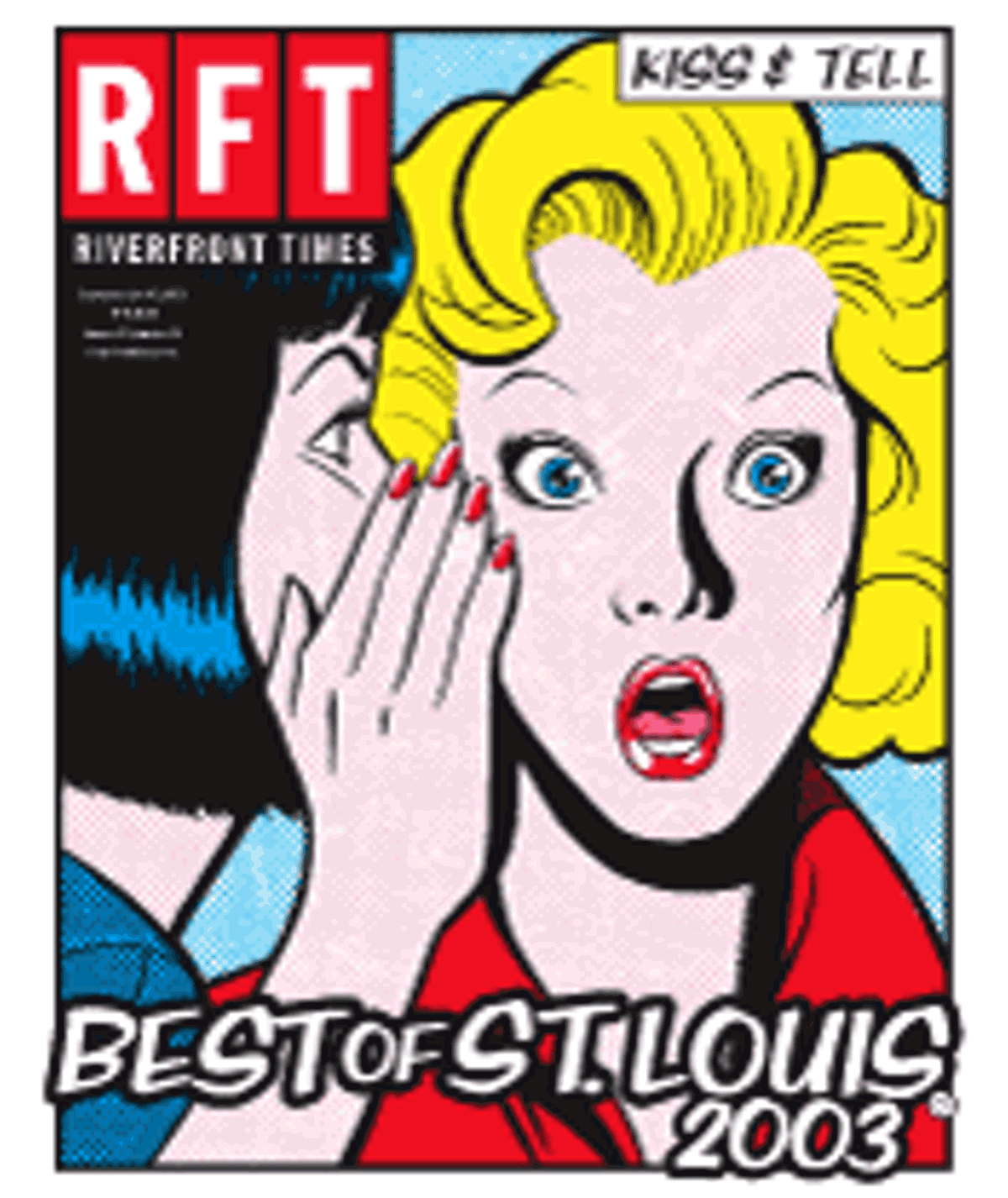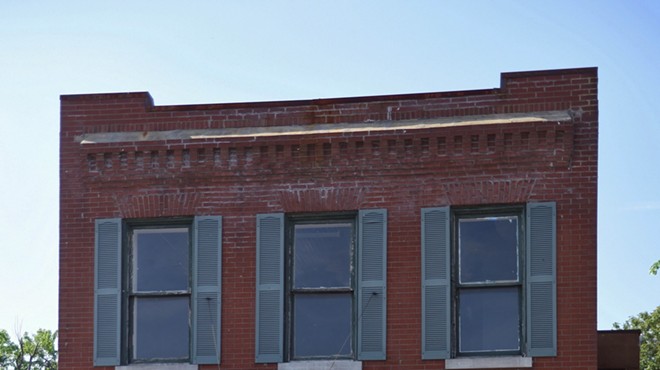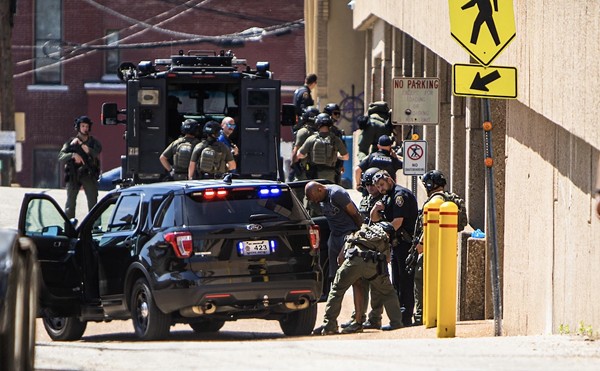To sculptor, gallery owner and art teacher Robert Powell, 58, St. Louis' "Gateway to the West" slogan is a steaming pile of toxic brain dung. "This crazy slogan -- it says 'come to St. Louis and then make your way west," he says, fuming and pacing around the hardwood first floor of his marvelously restored, mid-nineteenth-century Grand Center gallery. "There's nothing that says 'come to St. Louis.'" Unless, of course, you consider Powell's workspace, Portfolio Gallery and Educational Center, tucked behind Powell (no relation) Symphony Hall at 3514 Delmar Boulevard. Powell's deft curation yields a consistently eclectic and high-caliber annual schedule of African-American art exhibits at Portfolio. In addition to showing the work of nationally-recognized artists, Powell's instructional outpost a few blocks up the road teaches budding young artists how to connect their work to the urban streetscape, as evidenced by Portfolio's many murals downtown that liven up what would otherwise be drab, plywood construction sites. A Kansas City native and unabashed critic of suburban flight among his fellow African-Americans, Powell retains a residential roost near O'Fallon Park in north St. Louis and is a stealth player in St. Louis' political landscape -- his gallery was commissioned to create former Mayor Freeman Bosley's official portrait. And yet, Robert Powell is largely invisible to the public, plying his culturally significant craft as zeitgeist galleries a few blocks east pour most of their hipper-than-thou energy into pop art, apple martinis and buzz. Sure, Powell -- who faintly resembles actor John Amos -- talks. But then he walks -- proudly and with considerable substance. His enterprises are labors of tender love for his people and his adopted hometown. Ain't no half-steppin' in his game. (For more information, call 314-533-3323 or visit www.portfoliostl.com.)
Cue the "Theme From Jaws." He's back. And if the water's safe, meetings of the St. Louis Board of Education most assuredly are not, at least if you hold an opinion that differs from the Schoemehlmeister's. Don't agree with Schoemehl? Well, you're a Nazi. He and fellow new board members, anointed by Mayor Francis Slay and Civic Progress, are reforming the city's schools for your own good, so get used to it. Even after three terms as mayor (during which time he was burned in effigy by airport-expansion opponents), Schoemehl hasn't figured out that this is a democracy, at least on paper. Hiring fancy-suited consultants, closing schools in north-side neighborhoods and slashing jobs was bound to bring a little criticism. Why not let people vent a little? After all, it's their right. Instead, Schoemehl likened his critics to "brownshirts" and suggested using "police powers" to control school board meetings. It barely matters that he formally apologized (even going so far as voting to censure himself) for his rantings. The die was cast: He won this award fair and square.
Earlier this year, when Mayor Francis Slay backed a slate of candidates for the St. Louis Board of Education, he knew he was in for some rough sailing. But he couldn't possibly have predicted that the move would earn him a curse of biblical proportions. Yet that's precisely what got heaped upon his head when incumbent school-board member Rochell Moore, incensed by the Slay slate's support of a consultant's recommendation to shutter sixteen city schools, fired off an open letter to the mayor. Drawing heavily on Deuteronomy, Moore's missive predicts that "The LORD shall send upon Francis Slay and anyone who helps him cursing, vexation, and rebuke, in all that thou settest thine hand unto for to do, until thou be destroyed, and until thou perish quickly; because of the wickedness of thy doings." As if that weren't enough, "The LORD shall smite Francis Slay and anyone who helps him with a consumption, and with a fever, and with an inflammation, and with an extreme burning, and with the sword, and with blasting, and with mildew." So there.
The St. Louis area might not be known for grand natural resources, but less than fifteen miles upstream from the Arch, the counties of Madison, Jersey, Macoupin, Calhoun and St. Charles, stretching along the Mississippi and Illinois confluence, from Pere Marquette at the north to Alton at the south, are home to a lush but delicate ecosystem of forests, streams, bluffs, prairies and wetlands. In its eleventh year, the Great Rivers Land Trust has invested millions to protect thousands of acres facing erosion, pollution and commercial exploitation. In another ten years the trust hopes to protect another 5,000 acres. Along with land acquisition and easements, the GRLT has also acted as a cagey liaison between local farmers, the U.S. Environmental Protection Agency and the Illinois-American Water Company to improve water quality in the region and has taken its message of conservation into area schools and community colleges. If you've ever marveled at the Acadian landscape along the Great River Road, credit Mother Nature first, but don't forget the GRLT.
Calvary Cemetery boasts the biggest collection of dead Roman Catholics in St. Louis, but that's not the only reason to celebrate this mid-nineteenth-century treasure on the city's north side. Unlike Bellefontaine Cemetery, Calvary's slightly older and equally ornate neighbor immediately to the east, Calvary lays claim not only to a goodly number of the city's yesteryear movers-and-shakers, it's also the final resting place for one of the city's co-founders, Auguste Chouteau. (The remains of the city's other founder, Pierre Laclede, are lost to history.) Other dead luminaries parked at Calvary include ex-slave Dred Scott, who lost his legal fight for freedom but not his dignity, and U.S. General William Tecumseh Sherman, who gave the South its just deserts. Calvary's also the last stop for playwright and poet Tennessee Williams, gone two decades this year. Williams and his mother, Edwina Dakin Williams, both have large tombstones. Rose Isabelle Williams, Tennessee's sister, does not. Rose, who died in 1996, spent most of her 87 years on earth in a mental institution. She was lobotomized in the 1940s. On her marker is the inscription, "Blow out the candles, Laura" -- a line from Tennessee's Glass Menagerie. Creepy, huh? Calvary last year was named by USA Today as one of the nation's top ten places to "spend a day among the dead." A cemetery visit is an opportunity to ponder the vagaries of life and to capture a piece of the tranquility known only to the dead. And judging from the dead soldier we spotted in a hollowed-out tree, it's a quiet place to have a beer -- though we imagine that practice is not encouraged. Calvary is open 365 days a year, but gates close at 5 p.m. Be sure to request a map at the front office.
Tell them: "Follow Route 66 until you get to the stoplight at Route 66. Then take a right or left onto Route 66 -- or go straight until you get to Route 66." Route 66 is everywhere in St. Louis. Literally. Trekkin' west on Farty-Far? No, you're not -- you're really on Route 66. Heading into Lafayette Square in search of a chance encounter with a hottie walking a Dandie Dinmont terrier? She'll be sure to remind you that you're actually on Route 66, even if you've noticed the brown roadside insignia while en route. Why the ubiquity, you ask? Chalk this up to Route 66's eight varying alignments during its 1926-to-1985 run as an official U.S. highway. In essence, no matter what River City road you're on, odds are you're just a few stoplights away from the historic, pre-interstate strip of asphalt that has its own fan club and magazine. In a way, this is fitting. St. Louis, you see, is a city that has seen better days -- a forgotten town that peaked back when soda fountains and motels lined the mother road. Still, the serpentine stretch haunts us. And as for the tourist who asks how to find any notable edifice from the original Ted Drewes to Six Flags, just tell the schmo to head on down Route 66 and turn when he gets to Route 66. For living in a town that has taken more than its share of lumps over the years, we're entitled to a hyper-snooty inside joke or two.
Over the course of the past four years, construction workers have peeled away the misguided 1965 "modernization" that covered the stately limestone façade of the old Post-Dispatch building (the Post jumped ship and headed seven blocks north in 1959) with a boring quasi-Bauhaus shell, and the hatching process for downtowners has been a revelation. What was once a charmless square box has been reborn as a royal gem, thanks to developers Jerome Glick and H. Meade Summers, who peeked underneath and then committed cash to restoring the building to its original 1917 grandeur. The building's prominent location -- right at the corner of Olive Street and Tucker Boulevard -- has allowed thousands to witness the transformation: Once the steel panels were removed, the building's accumulated grime and ruddy façade seemed unsalvageable. Now, though, the edifice shines, and where once there was something nondescript, then sad and ugly, there is now, after a heavy-duty sandblasting, a glorious declaration. Inside, each of the eight floors will be renovated as it is leased, but, aside from a few loose ends, it's the outside we're giddy about. The grand opening and ribbon-cutting are scheduled to take place later this fall.
There's a great line in last year's screen gem Roger Dodger, when Campbell Scott's obnoxiously misanthropic Roger orders his hesitant sixteen-year-old nephew Nick to "drink that drink" at a trendy Manhattan bar, offering the rationale: "Drinking has been a social lubricant for hundreds of years. You think you're going to reinvent the wheel?" Well put. And what situation requires more lubrication than a first date? Ergo, coffee, the zoo and lunch are bad ideas when it comes to leaving a first impression that could lead to a second rendezvous. While normal wine bars are a bit on the cheesy side for this sort of venture, Nik's Wine Bar & Hookah Lounge defies conventional wisdom. More rock and reggae than quiet clinks and cabernet, Nik's doesn't stop at wine. The tequila-shot sampler, for instance, is sure to get conversation cooking. From there, of course, it's up to the two of you.
There are at least as many places as ways to leave your lover. Some are more cruel than others. Excusing yourself to grab a beer at Busch Stadium and then hopping MetroLink, for instance, is a strategy that should be employed only if you truly want to make a statement and the other party really deserves it. Even then, the Cards are only in town a guaranteed 81 times a year, and some of those games are sold out. You need something more reliable, and -- unless your relationship is the kind aired on Jerry Springer and Judge Hatchett -- a bit less dramatic. The perfect place to end a relationship has a bit in common with the perfect bank job. You need easy freeway access and plenty of parking, because you'll be leaving (and therefore, ideally, arriving) in separate cars. You don't want to linger any longer than necessary. And you don't want to go anyplace where someone might recognize you. After all, this might get messy. And understandably, you don't want to spend a lot of money. The time for $200 sushi tabs has long since passed. You're at the Bud-longneck and gee-the-meatloaf-sounds-good phase. There's nothing like comfort food to soothe a broken heart, and Pat's has it in spades, along with plenty of beer and harder stuff if you need a little liquid courage to get you through this. The place gets crowded at dinner time, but that's just enough to cover a difficult conversation.
Putting out a newspaper by yourself is a labor we wish on no one. It took Sylvester Brown fifteen years to realize he was doing the impossible by publishing Take Five from his home. With help from his wife, Brown wrote and edited the stories. He sold the ads. He did the layout. He delivered the finished product to newsstands, staying a half-step ahead of creditors who didn't care that he was producing the city's best newspaper aimed at the African-American community. He usually walked away with an armful of Excellence in Communications awards at the annual ceremony sponsored by the Greater St. Louis Association of Black Journalists, topping bigger rags that published more often and with bigger budgets. With a family to feed, Brown time and again threatened to cease publication. In May he finally did. The city had lost an important voice. But not for long. Less than a month after the final edition of Take Five hit the streets, Brown became a metro columnist for the St. Louis Post-Dispatch, a prize gig for any journalist. Brown's was not the traditional path to media star, and it shows in his plainspoken style. Raised a Jehovah's Witness, he left home at age seventeen and worked a series of low-paying jobs before Laclede Gas hired him as a construction worker. His academic credentials come from Forest Park Community College. While it's too early to predict his trajectory at the staid Post, it's already fun to read Brown as he works to find his voice within the constraints of a short column in St. Louis' only daily.








